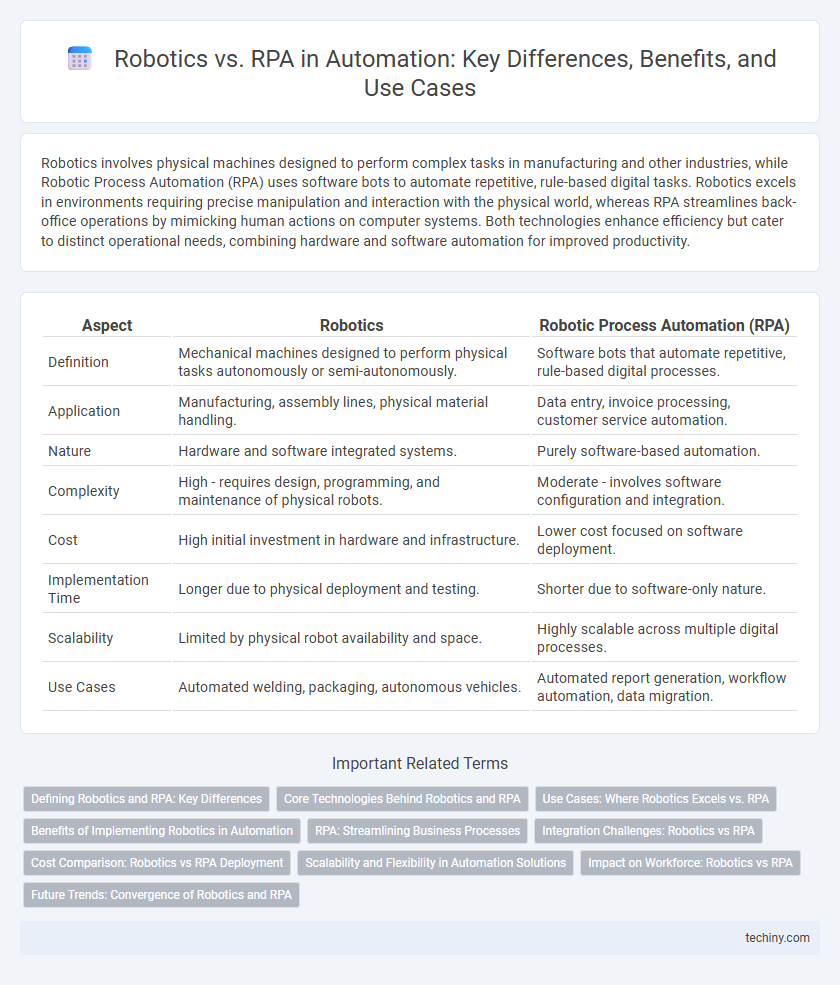Robotics involves physical machines designed to perform complex tasks in manufacturing and other industries, while Robotic Process Automation (RPA) uses software bots to automate repetitive, rule-based digital tasks. Robotics excels in environments requiring precise manipulation and interaction with the physical world, whereas RPA streamlines back-office operations by mimicking human actions on computer systems. Both technologies enhance efficiency but cater to distinct operational needs, combining hardware and software automation for improved productivity.
Table of Comparison
| Aspect | Robotics | Robotic Process Automation (RPA) |
|---|---|---|
| Definition | Mechanical machines designed to perform physical tasks autonomously or semi-autonomously. | Software bots that automate repetitive, rule-based digital processes. |
| Application | Manufacturing, assembly lines, physical material handling. | Data entry, invoice processing, customer service automation. |
| Nature | Hardware and software integrated systems. | Purely software-based automation. |
| Complexity | High - requires design, programming, and maintenance of physical robots. | Moderate - involves software configuration and integration. |
| Cost | High initial investment in hardware and infrastructure. | Lower cost focused on software deployment. |
| Implementation Time | Longer due to physical deployment and testing. | Shorter due to software-only nature. |
| Scalability | Limited by physical robot availability and space. | Highly scalable across multiple digital processes. |
| Use Cases | Automated welding, packaging, autonomous vehicles. | Automated report generation, workflow automation, data migration. |
Defining Robotics and RPA: Key Differences
Robotics involves the design, construction, and operation of physical robots that perform tasks autonomously or semi-autonomously in manufacturing, healthcare, and logistics. Robotic Process Automation (RPA) focuses on software robots that automate repetitive, rule-based digital tasks within business processes without human intervention. The key difference lies in robotics addressing physical automation while RPA targets automation of digital workflows.
Core Technologies Behind Robotics and RPA
Robotics relies on sensors, actuators, and embedded systems to perform physical tasks autonomously, emphasizing mechatronics and real-time control algorithms. Robotic Process Automation (RPA) uses software bots scripted to mimic human actions within digital systems, leveraging technologies like artificial intelligence, machine learning, and workflow automation to execute repetitive rule-based tasks. Core technologies in robotics focus on hardware integration and spatial awareness, while RPA centers on software-based data extraction, user interface interactions, and process orchestration.
Use Cases: Where Robotics Excels vs. RPA
Robotics excels in environments requiring physical interaction with machinery, such as automotive manufacturing and warehouse automation, where precision and endurance are critical. RPA is best suited for repetitive, rule-based digital tasks like data entry, invoice processing, and customer service automation in banking and insurance sectors. By leveraging Robotics for tangible operations and RPA for digital workflows, organizations optimize efficiency across diverse use cases.
Benefits of Implementing Robotics in Automation
Implementing robotics in automation significantly enhances operational efficiency by enabling precise, consistent, and high-speed task execution across complex manufacturing processes. Robotics reduces human error, increases workplace safety by handling hazardous tasks, and supports scalability through easy reprogramming for diverse functions. Organizations leveraging robotics experience improved product quality, lower labor costs, and accelerated production cycles, driving a competitive advantage in dynamic markets.
RPA: Streamlining Business Processes
Robotic Process Automation (RPA) focuses on streamlining business processes by automating repetitive, rule-based tasks such as data entry, invoice processing, and customer service workflows. Unlike robotics that involve physical machines, RPA operates at the software level, interacting directly with digital systems to enhance efficiency and accuracy. Implementing RPA leads to cost reductions, faster processing times, and improved compliance across various industries including finance, healthcare, and manufacturing.
Integration Challenges: Robotics vs RPA
Robotics integration involves complex hardware-software synchronization, requiring specialized engineering and real-time data processing capabilities. RPA integration challenges center on software compatibility, involving legacy systems, workflow automation, and maintaining data security across platforms. Both approaches demand tailored solutions for seamless interoperability, with robotics emphasizing physical adaptability and RPA focusing on digital ecosystem harmonization.
Cost Comparison: Robotics vs RPA Deployment
Robotics deployment typically involves higher upfront capital expenses due to robotic hardware acquisition and complex integration with manufacturing systems, while RPA (Robotic Process Automation) primarily incurs lower software licensing and implementation costs focused on automating digital workflows. Total cost of ownership for Robotics includes maintenance of physical robots, energy consumption, and workspace modifications, whereas RPA costs revolve around software updates, bot management, and scalability within IT environments. Enterprises often find RPA more cost-effective for automating repetitive clerical tasks, whereas Robotics suits capital-intensive production processes demanding physical manipulation.
Scalability and Flexibility in Automation Solutions
Robotics in automation excels in scalability by handling complex, repetitive tasks across large-scale manufacturing processes, enabling enhanced operational efficiency. Robotic Process Automation (RPA) offers superior flexibility by automating rule-based digital tasks with minimal coding, allowing quick adaptation to changing business workflows. Combining robotics and RPA creates a comprehensive automation strategy that maximizes scalability while maintaining the flexibility to respond to evolving organizational needs.
Impact on Workforce: Robotics vs RPA
Robotics automation significantly transforms the workforce by replacing manual, repetitive tasks with physical machines, often requiring upskilling for technical maintenance roles. Robotic Process Automation (RPA) enhances employee productivity by automating rule-based, software-driven tasks, allowing workers to focus on higher-value activities without extensive workforce displacement. Both technologies drive operational efficiency, but RPA tends to augment human roles, while robotics may lead to more profound shifts in job functions and labor demand.
Future Trends: Convergence of Robotics and RPA
The convergence of Robotics and Robotic Process Automation (RPA) is driving the next wave of automation innovation, integrating physical robots with intelligent software bots to create hybrid systems capable of complex task execution. Future trends indicate increased adoption of AI-powered cognitive automation, enabling seamless collaboration between autonomous robots and RPA platforms to optimize workflows across manufacturing, logistics, and customer service sectors. This fusion enhances scalability and flexibility, empowering businesses to reduce operational costs and accelerate digital transformation initiatives.
Robotics vs RPA Infographic

 techiny.com
techiny.com